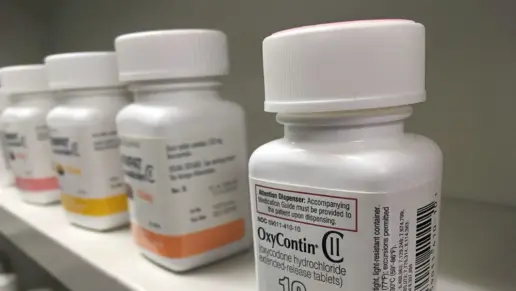The opioid epidemic is a concern across the United States. In 2020, the Centers for Disease Control and Prevention (CDC) reported that heroin was responsible for nearly 20% of all opioid overdose deaths. Heroin is an illegal opiate made from morphine, a natural substance derived from opium poppy plants. Combining morphine with chemicals to make heroin means that heroin is three times stronger, more addictive, and more dangerous than morphine.
We can help you to understand heroin addiction, the signs, symptoms, and treatment options so that you or your loved one can enjoy a life free from heroin. Learn more about opioid addictions.
What is Heroin?
 Heroin is an illegal opioid. Opioids can be prescribed or illegal, and they have various uses:
Heroin is an illegal opioid. Opioids can be prescribed or illegal, and they have various uses:
- Natural opioids: Examples include morphine and codeine, used for pain management.
- Semi-synthetic opioids: Heroin is a semi-synthetic opioid. This group also includes oxycodone, hydrocodone, hydromorphone and oxymorphone; along with buprenorphine, which is a synthetic opioid often used in the treatment of heroin use disorder.
- Synthetic opioids: These opioids are entirely artificial. Methadone is a well-known example of a synthetic opioid used to treat those addicted to heroin.
Heroin Street Names
Heroin is known as diacetylmorphine, diamorphine, and by various other names. Heroin has no medical use in the US. Therefore, as it can only be obtained illegally, those who deal in the substance give it a variety of street names to try to avoid detection by the authorities. Examples of these street names for heroin include big H, hell dust, thunder, snow, smack, skag, and white horse.
What Does Heroin Look Like
Heroin usually comes in the form of a white or brown powder or “black tar” heroin. The white powder is pure heroin that originates from South America, whereas black tar heroin contains impurities. Black tar heroin is usually dissolved and injected into veins, muscles, and under the skin. Highly pure heroin can be snorted or smoked, otherwise known as “chasing the dragon.” Smoking or snorting heroin may appeal to new users because it eliminates the stigma associated with injection drug use.
What Does Heroin Do?
Our bodies naturally produce neurotransmitters that bind to mu-opioid receptors (MORs) and help to regulate pain and feelings of reward and well-being. Heroin is an agonist that attaches to the MORs and stimulates the release of a neurotransmitter called dopamine. Dopamine produces a sense of pleasure and reward. By activating this process artificially through taking heroin, a link between taking the substance and the immediate sense of reward is created, reinforcing the drug-taking behavior. Heroin users often want to repeat or intensify the feeling by taking more heroin or a larger dose. The impact that heroin has is determined by factors such as how much heroin is taken, how long it takes to work, and how strongly it binds.
The National Institute on Drug Abuse (NIDA) states that repeated heroin abuse causes changes to the physical structure and physiology of the brain. Studies have shown that the brain’s white matter deteriorates as a result of heroin use which affects the user’s memory and decision-making abilities. Repeatedly taking heroin and causing an unnatural surge in hormones and neurotransmitters can also cause long-term hormonal imbalances. As a result, the brain can stop making these hormones, leading to severe mental health problems such as chronic depression.
How Many People Use Heroin?
Heroin use disorder is a form of substance use disorder (SUD). A SUD is diagnosed when a person cannot stop using a drug despite its detrimental effect on their life. The SAMHSA (Substance Abuse and Mental Health Services Administration) National Survey on Drug Use and Health reported that nearly 5.7 million people aged 12 and over had used heroin at least once in their lifetime. In addition, the 2020 survey found that 0.2% (691,000 people) had a heroin use disorder in the past 12 months.
Nearly 75% of the 91,799 drug overdose deaths in 2020 involved an opioid. Although the number of deaths involving heroin decreased by 7% between 2019 and 2020, heroin still contributed to more than 13,000 deaths in 2020, nearly seven times higher than in 1999.
Why Do People Use Heroin?
Heroin addiction can affect anyone. The reasons why someone uses heroin are varied and complex. Some of the most common reasons are:
Addiction to prescription opioids
The biggest risk factor for people using heroin is already being addicted to a prescription opioid painkiller. Initially, an individual may be prescribed painkillers for an injury, operation, or condition that causes chronic pain, and over time this can develop into an addiction to these painkillers. As the addiction grows, tolerance builds up, meaning that the user increasingly needs more of the drug to have the same effect.
Heroin Is more accessible and cheaper than prescription drugs
If someone has an addiction to prescription painkillers, they may find it increasingly difficult to source the medication. Their doctor may believe that the drug is no longer necessary and stop prescribing it. In this case, the patient will resort to visiting multiple doctors to obtain prescriptions for the same opioid. If it is impossible to obtain the drug by another means, the user may resort to getting it illegally or turn to heroin instead. Many opioid addicts state that they transitioned to heroin because prescription opioids are far more expensive and harder to obtain.
Chasing the high
Heroin provides a faster and greater sense of euphoria than other drugs. For those who use other substances such as ecstasy or marijuana, it can be tempting to use heroin to experience an even greater high. Once someone experiences heroin, it can be difficult to return to other drugs as they will no longer experience the same level of satisfaction from them. Once someone has started taking heroin regularly, they will begin to develop a tolerance to its effects. Therefore they will need to take more heroin more frequently to have the same effect. Withdrawal symptoms will also worsen, encouraging the user to take more heroin to alleviate these symptoms, leading to addiction.
Self-medication for pain
Drugs such as heroin provide instant euphoria and relaxation. Some people will use it to help them cope with stress or unhappiness in their lives. Similarly, those who suffer from social anxiety may choose to use heroin to help them feel more relaxed, comfortable, and confident in social situations. Some users will self-medicate with heroin when they think they have a condition that requires medical attention but do not wish to visit a doctor or pay a prescription charge for the medication they need.
Who Is at Risk of Becoming Addicted to Heroin?
Genetic, psychological, and environmental factors can predispose someone to develop a heroin addiction. Examples of these factors include:
- A family history of drug taking: Opioid use disorder can run in families, and studies have shown several genetic variants associated with heroin addiction.
- Mental health concerns: There is a strong link between mental health disorders such as anxiety and depression and substance addiction. More than half of those with a mental illness also experience a substance use disorder. In particular, the feeling of loneliness and being unwanted that comes with depression can lead someone to addiction. Drugs such as heroin provide comfort by numbing these feelings and making it easier for the user to deal with their pain and emotions.
- Unemployment: Studies have shown that unemployment is a significant risk factor for substance use disorders, as well as the risk of relapse after drug addiction treatment.
- Homelessness: As many as half of all people who are homeless have diagnosable substance use disorders. This situation can be complicated, as homelessness can cause someone to turn to heroin, but also heroin can be the reason they are homeless if it has caused them to lose their home, job, and family support.
- Drug-taking environment: Heroin use is more likely when someone has access to people and situations where heroin is used, or they feel under peer pressure to partake when others do. This particularly applies to young people. Studies into adolescent heroin abuse have found that adolescents can be attracted to the often exciting yet chaotic lifestyle of a heroin addict.
- Use at a young age: While young people do not commonly use heroin as much as some other drugs, it is still a cause for concern and often follows a young person’s abuse of prescription opioids.
Short-term Effects of Heroin Use
All drugs, legal or illegal, have side effects and risks associated with their use. In the case of heroin, the side effects depend on the amount taken and how rapidly it enters the brain. As an illicit opioid, heroin shares some risks with other opioid drugs but some side effects and risks are specific to heroin and how it has been administered.
How Long Does Heroin Last?
The rush of heroin use can last between 3 and 5 hours, and the short-term side effects can happen as soon as the heroin reaches the brain or in the hours after use. Major withdrawal symptoms usually peak between 48 and 72 hours after taking heroin.
Short-term Physical Symptoms of Using Heroin
- Drifting in and out of consciousness
- Reduced heart rate and blood pressure (this is particularly dangerous if the user has a pre-existing heart condition)
- Slowed breathing
- Heavy feeling in arms and legs with muscle aches
- Flushed skin that is warm to the touch
- Severe itching
- Dry mouth
- Small pupils
- Nausea and vomiting
- Intense cough if smoking heroin
- Track marks and bruising from injecting heroin
- Runny nose and nosebleeds due to snorting heroin
Short-term Mental Health Impacts of Using Heroin
- Drowsiness
- Trance-like state for several hours
- Confusion and disorientation
- Lethargy
Risk of Overdose
Like all drugs, heroin carries a concerning risk of overdose. In the case of heroin, an overdose occurs when the substance depresses a person’s heart rate and breathing to a level where they cannot survive without medical help. Even if someone does not die from an overdose, they can still suffer a debilitating brain injury – either an anoxic brain injury when the brain does not get any oxygen or a hypoxic brain injury due to the brain getting some but not enough oxygen.
The risk of overdose is often perpetuated by the intentional or unintentional combining of substances which can have unpredictable outcomes. For example, some users intentionally mix heroin with crack cocaine, known as “speedballing.”
In many cases, heroin is combined with other substances without the user’s knowledge. These can be relatively harmless substances such as sugar or powdered milk or more dangerous substances that can lead to life-threatening consequences. For example, heroin is often mixed with fentanyl, an opiate that is 50 to 100 times more potent than morphine. Fentanyl is added to heroin to increase its potency or be disguised as highly potent heroin as less is required to achieve the same effect, and therefore it is more cost-effective for the dealer. This mixing of substances can lead to overdose as users take a far greater opiate dose than they realize.
Long-term Health Risks of Heroin Use
Long-term use of heroin can lead to a physical dependence on the drug that has serious health implications. The health risks and withdrawal signs can last for many months or even years.
Long-term Physical Impact of Using Heroin
- Constant severe itching
- Cold flashes with goosebumps
- Debilitating cravings
- Constipation
- Sexual dysfunction
- Hormonal imbalances
- Lung damage
- Nasal tissue damage
Long-term Effects on Mental Health Due to Heroin Use
- Chronic insomnia
- Behavioral changes
- Memory loss
- Mood swings
- Chronic depression
What Are the 4 Stages of Heroin Addiction?
Heroin addiction develops over time, and users generally follow a similar use pattern. The high that is experienced from heroin is intense, and the desire to replicate it is powerful; therefore, users can advance through the stages more quickly with heroin than with other drugs. The 4 stages of heroin use disorder are:
- Stage 1: Experimentation: At this stage, the drug user may experiment with several different drugs and start snorting heroin. They may have an existing addiction to a prescription opioid and be developing a tolerance to it or struggling to get supplies and, therefore, turn to heroin as a replacement.
- Stage 2: Occasional use: The next stage is for someone to use heroin occasionally. They may not actively seek it out, but they will take it when offered to them and start associating with others who use it so that it will become normalized.
- Stage 3: Regular use: The user may have transitioned from snorting or smoking heroin to taking it intravenously. One study found that the most common change in heroin administration was from smoking to injecting. As injecting the substance means that it immediately reaches the bloodstream, and therefore, the brain, the user experiences a quicker and more intense high. This can lead to a greater chance of addiction as the heroin user is more likely to want to replicate this feeling. At this stage, the user will be experiencing drug cravings, and their life will be detrimentally affected by their use of heroin.
- Stage 4: Addiction: A heroin addict’s life will have become entirely consumed by their addiction. They may have resorted to crime to fund their habit, their relationships with others will have broken down, and they cannot keep a job. Their health will be affected; they may have experienced an overdose and require medical attention.
What Are the Signs of Heroin Use?
People with drug addiction often go out of their way to hide their habit from those around them, and therefore, unless you see them taking drugs or find drugs in their belongings, it can be challenging to know for definite that they have a substance use disorder. There are, however, signs that you can look out for that indicate that someone has heroin addiction:
- Behaving out of character: When individuals are experiencing the euphoria associated with taking heroin, or they are suffering from withdrawal symptoms, they may act in a way that is out of character for them. They may be particularly lethargic, confused, and disorientated. They may also start to lie or become particularly secretive. Withdrawal from heroin may result in displays of anger, depression, or anxiety.
- Suffering heroin withdrawal symptoms: When someone with heroin addiction is not taking the substance, they will suffer from physical and noticeable severe opioid withdrawal effects, including vomiting, diarrhea, excessive sweating, shivering, or sleeping significantly more than usual. Major withdrawal effects can last for a week after the last dose of heroin.
- Declining performance at work or school: Heroin addiction takes over everything else in life, meaning the user cannot focus on anything other than finding and taking more of the substance. A noticeable decline in performance at work and school can result, including potentially losing their job or failing classes.
- Lack of interest in activities: Similarly, someone with a heroin addiction may not be interested in or cannot gain pleasure from anything that does not involve taking the drug. They may start to lack motivation for things they previously enjoyed, such as participating in sports, recreational hobbies, or socializing.
- Distancing themselves from friends and family: Heroin addicts often isolate themselves from friends and family because they feel ashamed or fear being judged. Substance addiction can destroy personal relationships, and some individuals become estranged from their friends or family.
- Financial troubles: As a drug addiction intensifies, it becomes more expensive. Often those with heroin addiction will start to require loans from friends or family members for unexplained reasons and then struggle to repay them. This is especially true if they have lost their job due to addiction.
- Needle marks: A physical sign that someone is a heroin addict is the needle marks associated with injecting the drug. As use intensifies, the marks may become inflamed or infected, and boils may develop. A person with a heroin addiction may start to cover their skin to avoid detection of these marks; this can be especially noticeable on hot days or during activities requiring specific clothing.
- Experiencing health problems: As well as suffering withdrawal symptoms that impact their health, heroin addicts are also at enhanced risk of contracting diseases. Heroin use increases the risk of exposure to HIV, viral hepatitis, and other infectious agents. This increase is due to sharing intravenous needles, paraphernalia, and close contact with bodily fluids. The euphoria associated with heroin use can also lead to someone engaging in unprotected sexual activity with multiple partners, resulting in sexually transmitted diseases and unplanned pregnancies.
- Taking risks and poor decision-making: Using heroin and the desire to alleviate withdrawal symptoms can impact an individual’s ability to make rational decisions and effectively assess risk. They may start to:
- Associate with criminals: Someone with a heroin addiction may begin socializing with people they would not usually associate with, including other drug users and drug dealers.
- Partake in criminal activity: When someone has a substance use disorder, they may steal money or items to sell or make money through other means to pay for drugs. Illegal activities can include dealing heroin themselves or prostitution.
- Become involved in violence: The people, risks, and money involved with sourcing and dealing heroin can result in acts of extreme violence. Someone with a heroin addiction may find themselves at the receiving end of violence or be recruited to commit violent acts to pay for their heroin supply.
- Get into trouble with the police: Often, it is the case that a drug addict’s criminal associations and activities will result in them getting into legal trouble. They may be fined, undertake community service, or be sent to prison.
How To Find Help for Heroin Use Disorder
If you think you or a loved one has a heroin addiction, it’s time to seek professional help. Early intervention can help to prevent the risk of severe health risks or overdose. The right substance abuse treatment provider can help patients to understand their addiction and the treatment they need and embark on a life of sobriety. Knowing where to begin to look for heroin addiction treatment can be challenging. Examples of trusted resources with valuable information about addiction and treatment options are:
- SAMHSA’s National Helpline is free and confidential, and available daily. You can get advice on treatment options and find addiction treatment centers near you. Call: 1-800-662-HELP (1-800-662-4357).
- Rehab.com offers trustworthy online advice and resources and a helpline to connect people needing help with treatment providers that care. Visit the website or call now at (833) 386-0206.
- Your doctor is an excellent source of local knowledge and information. They will be able to put you in touch with available resources in your local area.
- Narcotics Anonymous and other support groups are available across the US. These meetings are generally free or inexpensive to attend and can be valuable for peer support and guidance.
- If you feel comfortable doing so, you can ask your friends and family for advice. Often people you know have personal experience of substance addiction or know people that do. Personal recommendations, contacts, and information can help narrow the search for addiction treatment in your area.
What To Expect From Heroin Addiction Treatment
Your most effective heroin addiction treatment program will depend on your individual needs and situation. The treatment plan offered may involve:
- Detoxification: Many healthcare providers will offer medical detox as a starting point for heroin addiction treatment. This process involves the patient being weaned off heroin under the care of medical professionals. The patient’s opiate withdrawal symptoms are monitored and controlled, and they are kept as comfortable as possible. Medical detox is crucial when someone is addicted to heroin as the withdrawal symptoms are especially severe compared to other drugs.
- Anaesthesia-assisted Rapid Opiate Detoxification (AAROD): May be recommended in some cases. Detoxification by AAROD can be achieved in approximately 1 hour through sedation of the patient and intravenous administration of medication such as midazolam, propofol, and naloxone. Naloxone is also extremely useful in the event of an opioid overdose as it is an opioid antagonist medication and rapidly reverses its effects on the body.
- Medication-assisted treatment: Prescription medications used to treat those with heroin use disorder include buprenorphine, naltrexone, or suboxone which is a combination of the two. Methadone is one of the most well-known medications that’s been used for years to treat heroin addiction. However, it is essential to understand that it is not a quick fix and that some patients may require lifelong methadone maintenance to maintain sobriety.
- Behavioral health treatment: A successful rehabilitation program will incorporate a variety of therapies designed to improve a patient’s behavioral health. These often start with understanding why heroin addiction has occurred and developing methods to overcome it. Treatment programs can include inpatient or outpatient options.
- Aftercare: The relapse rate for opiate-dependent patients is around 91%. This is significantly higher than other drugs due to the intense effects of heroin and other opioids, their accessibility and affordability, and the intensiveness of the withdrawal symptoms. Following addiction treatment, it is essential to embark upon an aftercare program to achieve long-term recovery. This program can include a stay at a sober living house, ongoing therapy on an outpatient basis, and peer support groups.
Heroin addiction can have a devastating effect on your life and the life of your friends and family. It can be challenging to know where to begin with seeking help but rest assured that heroin addiction treatment is widely available and effective. The sooner you or your loved one starts treatment, the greater the chance of success and the less chance of experiencing the debilitating consequences that heroin addiction can have on a person.
Addiction treatment programs for heroin are designed with the patient in mind. Everyone’s treatment is different, and you will be able to find the program that is right for you. The most important thing you can do now is to call one of the trusted and knowledgeable resources we have provided and take your first step toward a life free from heroin.




